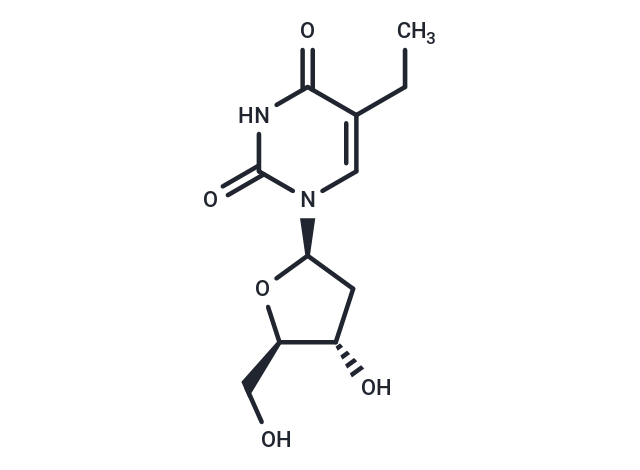Shopping Cart
- Remove All
 Your shopping cart is currently empty
Your shopping cart is currently empty

Edoxudine (Epoxudine), an antiviral drug, is an analogue of thymidine and shows effectiveness against the herpes simplex virus. Edoxudine is used as a 5-fluorouracil (FU) modulator. Edoxudine may be used to enhance the therapeutic index of 5-FU by reducing the catabolism, prolonging the plasma and intratumoral concentrations of 5-FU, and offering protection to normal organs by increasing the endogenous uridine levels. It can also enhance the antitumour action of 5-FU.

| Pack Size | Price | Availability | Quantity |
|---|---|---|---|
| 10 mg | $46 | In Stock | |
| 25 mg | $78 | In Stock | |
| 50 mg | $116 | In Stock | |
| 100 mg | $197 | In Stock | |
| 1 mL x 10 mM (in DMSO) | $32 | In Stock |
| Description | Edoxudine (Epoxudine), an antiviral drug, is an analogue of thymidine and shows effectiveness against the herpes simplex virus. Edoxudine is used as a 5-fluorouracil (FU) modulator. Edoxudine may be used to enhance the therapeutic index of 5-FU by reducing the catabolism, prolonging the plasma and intratumoral concentrations of 5-FU, and offering protection to normal organs by increasing the endogenous uridine levels. It can also enhance the antitumour action of 5-FU. |
| Alias | EUDR, Epoxudine, Aedurid |
| Molecular Weight | 256.26 |
| Formula | C11H16N2O5 |
| Cas No. | 15176-29-1 |
| Smiles | CCc1cn([C@H]2C[C@H](O)[C@@H](CO)O2)c(=O)[nH]c1=O |
| Relative Density. | 1.389 g/cm3 (Predicted) |
| Storage | Powder: -20°C for 3 years | In solvent: -80°C for 1 year | Shipping with blue ice. | |||||||||||||||||||||||||||||||||||
| Solubility Information | DMSO: 45 mg/mL (175.6 mM), Sonication is recommended. | |||||||||||||||||||||||||||||||||||
Solution Preparation Table | ||||||||||||||||||||||||||||||||||||
DMSO
| ||||||||||||||||||||||||||||||||||||

Copyright © 2015-2025 TargetMol Chemicals Inc. All Rights Reserved.